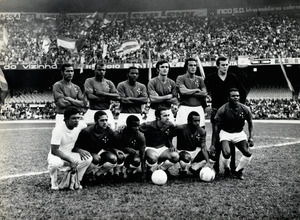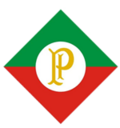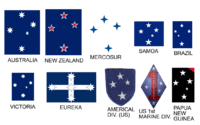Cruzeiro EC facts for kids
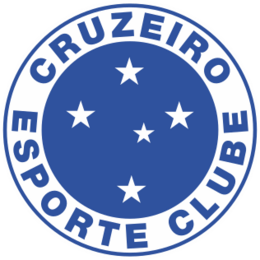 |
||||
| Full name | Cruzeiro Esporte Clube | |||
|---|---|---|---|---|
| Nickname(s) | Raposa (The Fox) Celeste (The Celestial) La Bestia Negra (The Black Beast) |
|||
| Founded | 2 January 1921 | |||
| Stadium | Mineirão | |||
| Capacity | 62,160 | |||
| SAF Owner | Pedro Lourenço (90%) Cruzeiro Esporte Clube (10%) |
|||
| President | Lidson Potsch | |||
| Head coach | Leonardo Jardim | |||
| League | Campeonato Brasileiro Série A Campeonato Mineiro |
|||
| 2022 2022 |
Série B, 1st of 20 (champions) Mineiro, 2nd of 12 |
|||
|
||||
Cruzeiro Esporte Clube is a famous Brazilian professional football club from the city of Belo Horizonte. While the club is involved in many sports, its football team is the most well-known. Cruzeiro plays in the Campeonato Brasileiro Série A, which is the top football league in Brazil. They also compete in the Campeonato Mineiro, the main state league of Minas Gerais.
The club was started on January 2, 1921, by Italian immigrants in Belo Horizonte. It was first named Società Sportiva Palestra Itália. During World War II, Brazil's government banned names related to enemy countries. So, in 1942, the club changed its name to Cruzeiro, after the Southern Cross star constellation, a major symbol of Brazil.
Cruzeiro is one of the most successful clubs in Brazil. They have won the top national league, the Brasileirão, four times. Their 2003 season was amazing, as they scored 100 points. They also hold the record for winning the Copa do Brasil (Brazil's Cup) six times. In 2003, Cruzeiro achieved the "Domestic Treble" by winning the state league, the Copa do Brasil, and the Brasileirão all in the same year.
The team's biggest rival is Atlético Mineiro, and their matches are called the Clássico Mineiro. Many famous players have played for Cruzeiro, including Ronaldo, Rivaldo, Tostão, and Jairzinho.
Contents
History
Italian Roots and a New Name
Cruzeiro's story begins with the Italian community in Belo Horizonte. Just like Italians in São Paulo started the club Palmeiras, the Italians in Minas Gerais wanted their own team. On January 2, 1921, they founded the Società Sportiva Palestra Italia. At first, only people of Italian heritage could play for the team.
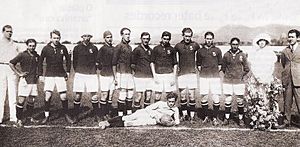
The club played its first game on April 3, 1921, and won 2–0. Their first official match was a 3–0 victory against their future rivals, Atlético Mineiro.
In 1942, during World War II, Brazil joined the war against the Axis powers, which included Italy. The Brazilian government made a rule that banned using names from these countries. The club had to change its name from Palestra Italia. After some discussion, they chose Cruzeiro Esporte Clube to honor the Southern Cross constellation, a symbol of Brazil. They also changed their colors from the Italian green, white, and red to blue and white, which are colors on the Brazilian flag.
The Golden Years: The "Mineirão Era"
When the famous Mineirão stadium opened in 1965, Cruzeiro began a very successful period. The team, which included stars like Tostão and Wilson Piazza, won its first national title in 1966. They beat the legendary Santos team, which featured Pelé.
In 1976, Cruzeiro won its first Copa Libertadores, South America's most important club tournament. They beat River Plate from Argentina in the final. The team almost won it again in 1977 but lost to another Argentinian team, Boca Juniors.
Ups and Downs
The 1980s were a difficult time for the club. They didn't win any major titles and had some of their worst finishes in the national league. But in the 1990s, things turned around. The club started a 15-year streak of winning at least one trophy every year.
The best moment in the club's recent history was in 2003. Cruzeiro won the "Triple Crown": the Campeonato Mineiro, the Copa do Brasil, and the Campeonato Brasileiro Série A. No other Brazilian team had done this before.
Recent Success and Challenges
Cruzeiro continued to be a top team, winning the Brasileirão again in 2013 and 2014. They played exciting, attacking football that many people admired.
However, the club later faced serious financial problems. This led to the team being relegated to the second division for the first time in its history in 2019. In 2021, the legendary player Ronaldo, who began his career at Cruzeiro, bought the club to help it recover. Under his ownership, Cruzeiro won the second division in 2022 and returned to Série A. In April 2024, Ronaldo sold the club to businessman Pedro Lourenço.
Symbols
Colors and Kits
When the club was Palestra Italia, its main color was green, like the Italian flag. The team was even nicknamed "periquito" (parakeet).
After becoming Cruzeiro in 1942, the club adopted blue and white as its main colors. The home kit is usually a blue shirt, white shorts, and white socks. The design has changed over the years, but the blue and white have remained.
Crest
The club's first crest was based on the Italian flag. When the name changed to Cruzeiro, the crest was changed to a blue circle with five white stars in the shape of the Southern Cross constellation.
Sometimes, the team's shirt doesn't have the full circle crest. Instead, it just has the five stars on their own. In 2006, a crown was added above the crest to celebrate the "Triple Crown" victory of 2003.
Mascot
The club's mascot is a fox, or raposa in Portuguese. It was created in the 1940s by a cartoonist named Mangabeira. He was inspired by a former club president who was known for being very clever and sly, just like a fox.
Today, a big mascot named Raposão (Big Fox) appears at every home game to cheer with the fans. There is also a smaller mascot named Raposinho (Little Fox).
Stadium
Since 1965, Cruzeiro has played its home games at the Estádio Governador Magalhães Pinto, better known as the Mineirão. It is one of the most famous stadiums in Brazil and is shared with their rival, Atlético Mineiro.
The Mineirão originally held over 130,000 people, but after renovations, it now holds about 62,000. The stadium hosted games for the 2014 FIFA World Cup. Cruzeiro holds the attendance record at the stadium, with 132,834 fans watching a match in 1997.
The club also has excellent training facilities. Toca da Raposa I (Fox's Lair I) is for the youth teams, and Toca da Raposa II is for the main team.
Famous Players
Many great players have worn the Cruzeiro shirt.
- Tostão is the club's all-time top goalscorer, with 249 goals. He was a key player for Brazil's winning team at the 1970 FIFA World Cup.
- Dirceu Lopes is another club legend who played alongside Tostão and scored 224 goals.
- Wilson Piazza was a World Cup-winning captain for Brazil and a star for Cruzeiro in the 1960s and 70s.
- Ronaldo started his amazing career at Cruzeiro before becoming one of the best strikers in the world.
- Fábio is the player with the most appearances for the club, playing in over 800 games as a goalkeeper.
Honours
Cruzeiro is one of Brazil's most decorated clubs. Here are some of their major titles:
- Copa Libertadores (2 times): 1976, 1997
- Campeonato Brasileiro Série A (4 times): 1966, 2003, 2013, 2014
- Copa do Brasil (6 times - Record): 1993, 1996, 2000, 2003, 2017, 2018
- Campeonato Brasileiro Série B (1 time): 2022
- Campeonato Mineiro (38 times)
Current Squad
|
|
Images for kids
See also
 In Spanish: Cruzeiro Esporte Clube para niños
In Spanish: Cruzeiro Esporte Clube para niños
- Cruzeiro Esporte Clube (women)
- Sada Cruzeiro (volleyball)
- List of Cruzeiro Esporte Clube managers
- List of Cruzeiro Esporte Clube players


